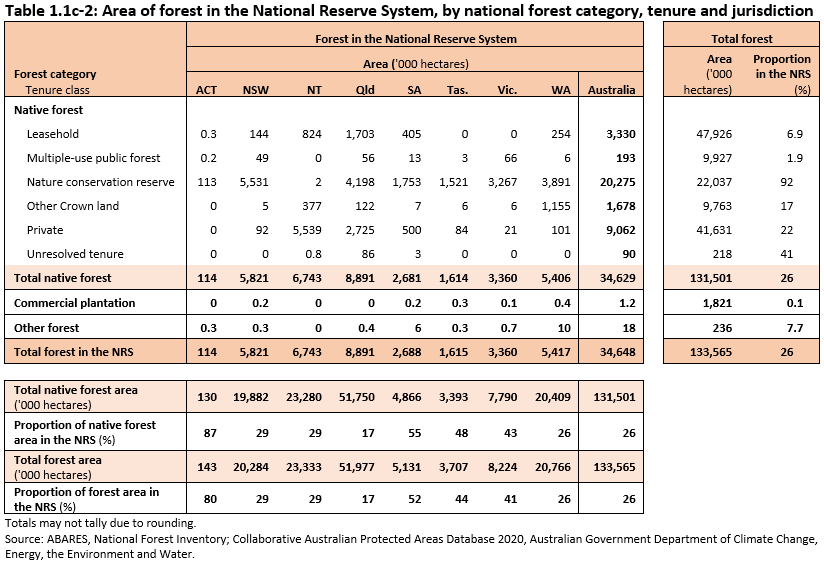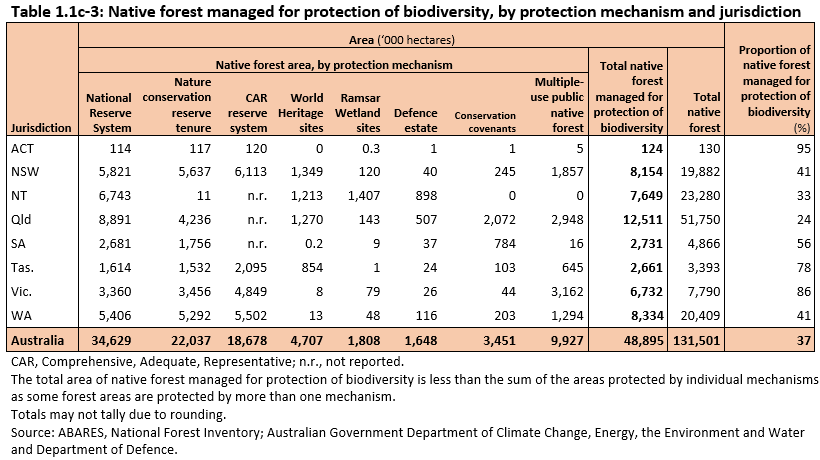This indicator uses the area and proportion of forest ecosystems reserved through formal and informal processes as a measure of the emphasis placed by society on the preservation of representative ecosystems as a strategy to conserve biodiversity.
This is the Key information for Indicator 1.1c, published July 2024.
- A total of 34.6 million hectares of Australia’s native forest (26% of total native forest area) is in the National Reserve System (NRS) of formal protected areas.
- Additional forest areas outside the NRS are managed for the protection of biodiversity under other mechanisms.
- A total of 48.9 million hectares of Australia’s native forest (37% of total native forest area) is managed for the protection of biodiversity, either in the NRS or under other mechanisms.
- A total of 3.5 million hectares of native forest is on conservation covenants or equivalent schemes that protect important natural values on privately managed land.
A range of formal and informal mechanisms are used to protect the biological diversity of forests on public and private land in Australia. This indicator reports on those mechanisms in which protection of biodiversity is a stated management intent, and on the area of forest subject to those mechanisms. Table 1.1c-1 lists the various applicable mechanisms that provide for the protection of forests in Australia.
Many forest areas are protected by more than one mechanism, and spatial intersection of these areas is needed to determine the total area of forest, and the mechanisms by which they are protected or managed for protection in Australia.
Table 1.1c-1: List of protection mechanisms
| Protection mechanism | Description |
| Australia's National Reserve System | The National Reserve System (NRS) is Australia’s network of protected areas, comprising dedicated Commonwealth, state and territory reserves, as well as certain protected areas on private land, Indigenous land, and land managed by conservation organisations. |
| Nature conservation reserve (tenure class) | The National Forest Inventory national tenure class ‘Nature conservation reserve’ comprises Crown land that is formally reserved for environmental, conservation and recreational purposes, including national parks, nature reserves, state and territory recreation and conservation areas. Not all such areas of nature conservation reserve tenure are captured in the National Reserve System. |
| CAR reserve system | The comprehensive, adequate and representative (CAR) reserve system is a reserve system on public and private land. On public land the CAR reserve system comprises dedicated formal reserves, informal reserves, and areas where forest values are protected by management prescriptions. There are also some CAR reserves on private land. |
| World Heritage areas | Areas deemed to have outstanding universal value for humankind under the Convention Concerning the Protection of the World Cultural and Natural Heritage (the World Heritage Convention) to which Australia is a signatory. |
| Ramsar List of Wetlands of International Importance | The Convention on Wetlands of International Importance (the Ramsar Convention) is an international treaty that aims to prevent worldwide loss of wetlands, and to achieve conservation and wise use of wetlands through cooperation and responsible national land management. |
| Defence estate | Land held by the Australian Government Department of Defence and subject to strategies and management practices that aim to maintain an environmentally sustainable estate. |
| Forest on conservation covenants and equivalent schemes | A land protection mechanism that is a voluntary, permanent and legally binding agreement between a landholder and a scheme provider to protect natural values. The scheme provider can include not-for-profit organisations, government agencies or local councils and typically occurs on privately managed land. Some state- and territory-based private land conservation covenant and equivalent programs are captured by the National Reserve System. |
| Multiple-use public forest (tenure class) | Areas of multiple-use public forests are included where biodiversity conservation is a specified management intent alongside multiple other values (e.g. timber production, water supply, recreation etc.), either through state or territory legislation, or regulation or management through a management planning instrument. |
The National Reserve System (NRS) is Australia’s formal network of protected areas. It is underpinned by a scientific framework and has the objective of developing a comprehensive, adequate and representative system of protected areas. To be protected and included in the NRS, an area of land must meet the International Union for Conservation of Nature (IUCN) definition of a protected area (Dudley and Phillips 2006).
National information on the NRS is reported in the Collaborative Australian Protected Areas Database (CAPAD), published every two years by the Australian Government Department of Climate Change, Energy, the Environment and Water. Analysis for this indicator used the CAPAD terrestrial spatial dataset, and included small areas of the CAPAD marine spatial dataset that occur over land.
A total of 34.6 million hectares of Australia’s native forest is protected in the NRS (26% of Australia’s native forest area) (Table 1.1c-2). Small areas of Commercial plantation and Other forest are also mapped within the NRS, largely due to historic changes in land tenure. The distribution of forest in the NRS across all land tenure classes in Australia is shown in Figure 1.1c-1, together with the distribution of forest managed for protection of biodiversity by other mechanisms.
The listing of an area in the NRS reflects formal declaration and management intent rather than any particular underlying land tenure. Of the area of native forest in the NRS:
- 20.3 million hectares of native forest are on the tenure class Nature conservation reserve (representing 92% of all native forest that is on Nature conservation reserve tenure)
- 9.06 million hectares of native forest are on Private tenure (representing 22% of all native forest on Private tenure)
- 3.33 million hectares of native forest are on Leasehold tenure (representing 6.9% of all native forest on Leasehold tenure).
The largest areas of native forest in the NRS, by state and territory, are:
- 8.89 million hectares in Queensland
- 6.74 million hectares in the Northern Territory
- 5.82 million hectares in New South Wales.
The highest proportions of native forest area in the NRS, by state and territory, are in:
- the Australian Capital Territory (87%)
- South Australia (55%)
- Tasmania (48%)
- Victoria (43%).
Table 1.1c-2 shows the area of forest in the NRS by forest category, tenure and jurisdiction.
Areas in the NRS are allocated to one of seven protection categories established by the IUCN (see Supporting information for Indicator 1.1c – Forest in the National Reserve System by IUCN protected area category).
Click here for a Microsoft Excel workbook of the data for Table 1.1c-2.
The National Reserve System (NRS) contains Australia’s formal reserves, but additional areas of forest outside of the NRS are managed under one or more of a range of other mechanisms that have protection of biodiversity as a management intent. These mechanisms are described in Table 1.1c-1.
Figure 1.1c-2 shows the area of native forest covered by each protection mechanism. The total area of native forest managed for protection of biodiversity, on land that is protected or where protection of biodiversity is a specified management intent, is 48.9 million hectares and 37% of Australia’s native forest estate (see footnote to Figure 1.1c-2).
Click here for a Microsoft Excel workbook of the data for Figure 1.1c-2.
Table 1.1c-3 shows the areas of native forest managed for protection of biodiversity, in the NRS and under other mechanisms, by jurisdiction. The distribution of native forest in the NRS, and native forest managed for protection of biodiversity outside the NRS, is shown in Figure 1.1c-1. Details of areas protected by different mechanisms are provided in Supporting information for Indicator 1.1c.
The largest areas of native forest managed for protection of biodiversity are in:
- Queensland (12.5 million hectares, 24% of total native forest in Queensland)
- Western Australia (8.33 million hectares, 41% of total native forest in Western Australia)
- New South Wales (8.15 million hectares, 41% of total native forest in New South Wales).
The highest proportions of total native forest area managed for protection of biodiversity are in:
- the Australian Capital territory (95%)
- Victoria (86%)
- Tasmania (78%).
Click here for a Microsoft Excel workbook of the data for Table 1.1c-3.
In December 2022 the Kunming-Montreal Global Biodiversity Framework was adopted by parties to the Convention on Biological Diversity (CBD), including Australia. This replaces the CBD Strategic Plan for Biodiversity 2011-20 and associated Aichi Biodiversity Targets and outlines a set of global biodiversity goals for 2050 and targets for 2030.
Of these targets, Target 3 aims to ensure that 30% of land and 30% of marine environments are effectively conserved and managed within protected areas or other effective area-based conservation measures (OECMs) (See Box 1.1c-1). OECMs are areas (other than Protected Areas) that have biodiversity conservation as a management goal, but not necessarily the sole or primary management goal. A National OECM Framework for recognising land-based OECMs in Australia was released in June 2024.
A total of 37% of Australia’s native forest is managed for the protection of biodiversity, either in the National Reserve System (NRS) or where protection of biodiversity is a specified management intent, and represents the contribution of native forests towards the Kunming-Montreal Global Diversity Framework Target 3. A total of 26% of both Australia’s total forest area and total native forest area is protected in the NRS. An additional 11% of Australia’s total forest area is outside the NRS but managed for the protection of biodiversity under other protection mechanisms.
Box 1.1c: Kunming-Montreal Global Biodiversity FrameworkTarget 3: Conserve 30% of Land, Waters and Seas Ensure and enable that by 2030 at least 30 per cent of terrestrial and inland water areas, and of marine and coastal areas, especially areas of particular importance for biodiversity and ecosystem functions and services, are effectively conserved and managed through ecologically representative, well-connected and equitably governed systems of protected areas and other effective area-based conservation measures, recognizing Indigenous and traditional territories, where applicable, and integrated into wider landscapes, seascapes and the ocean, while ensuring that any sustainable use, where appropriate in such areas, is fully consistent with conservation outcomes, recognizing and respecting the rights of Indigenous peoples and local communities, including over their traditional territories. Source: cbd.int/gbf/targets/3 |
Dudley and Phillips (2006) Forests and Protected Areas: Guidance on the Use of the IUCN Protected Area Management Categories. International Union for Conservation of Nature, Gland, Switzerland, and Cambridge, UK.
Dudley N (ed) (2008). Guidelines for Applying Protected Area Management Categories. Gland, Switzerland: IUCN.
UNEP CDB CBD (United National Environment Programme Convention on Biological Diversity) (2018). 14/8 – Protected areas and other effective area-based conservation measures. Decision adopted by the Conference of the Parties to the Convention on Biological Diversity Fourteenth meeting, Sharm El-Sheikh, Egypt, 17 to 29 November 2018.
Further information
Click here for Supporting information on Indicator 1.1c: Area of forest in protected area categories (2024), including:
- Forest in National Reserve System by IUCN protected area category
- Forest on Nature conservation reserve tenure
- Native forest in the CAR reserve system
- Native forest in World Heritage and Ramsar Wetland sites
- Native forest on the Defence estate
- Native forest on conservation covenants and equivalent schemes
- Multiple-use public forest (tenure class)




